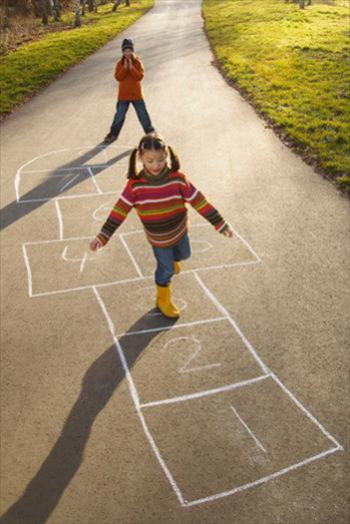A game of hopscotch
Duration/age

Hop, hop, hop and stop
Help your child to draw a hopscotch course with chalk on cement. You can make the course as long as you like, but it usually has about 8 or 10 squares. Draw a set of single and double squares - like a ladder, but with extra bits. Write a number on each square of the course.
Let’s write 1 on the first square and 2 on the next square. What number comes after that?
Once the hopscotch course is set up you’re ready to go. Talk about the game with your child as they play.
First we need to find a little stone.
Gently toss a stone or beanbag onto the first square and hop over it. Keep hopping to the end of the course. When there’s a pair of squares you can jump instead of hop. Try to land with a foot in each square.
At the end of the course turn around and hop and jump back again. Don’t forget to stop and pick up the stone along the way.
You made it all the way there and back again. That’s great! Now can you get the stone to land on number 2?
Ready for another go?
Materials you will need
- Stones
- Chalk
Alternative tools
- Beanbags
Skills this activity improves
Why does this matter?
As your child plays hopscotch they will be developing lots of physical skills. Tossing the stone or beanbag develops eye-hand coordination.
Hopping is a complex skill and takes lots of practice. When your child is practising they will be developing balance and coordination. They will also be making connections in their brain which will later help with creativity and reasoning.
As they stop and start in the game your child will be developing body rhythm and a sense of how their body moves.
Hopscotch also helps your child to recognise numbers and the way that they are ordered.
What does this lead to?
Well-developed motor skills, like balancing, hopping, and eye-hand coordination, all help children when they are writing and when moving around safely.
Body rhythm helps children as they are learning language as it helps them to notice rhythms in speech.
Language to use
- Hopscotch, course
- Chalk, draw, square
- One, two, three
- First, second, third
- Toss, stone, beanbag
- Hop, jump, balance
Questions to use
- What number comes next?
- Can you turn around at the end?
Useful tips
- You might also like to take a look at the Making marks activity.
- Remember to talk to your child in your home language.
More ideas
You can make a hopscotch course inside using masking tape on the carpet.
Variation by age
Three to five year olds
- Play a movement game with your child. Set them challenges like "Can you jump to the tree?" or "Can you hop around the clothesline?"
Questions to ask
- How high can you jump?
- How far can you crawl?
Language to use
- Hop, jump, crawl, run, slide


